Wine Cellar Cooling Units & Refrigeration Systems – Types
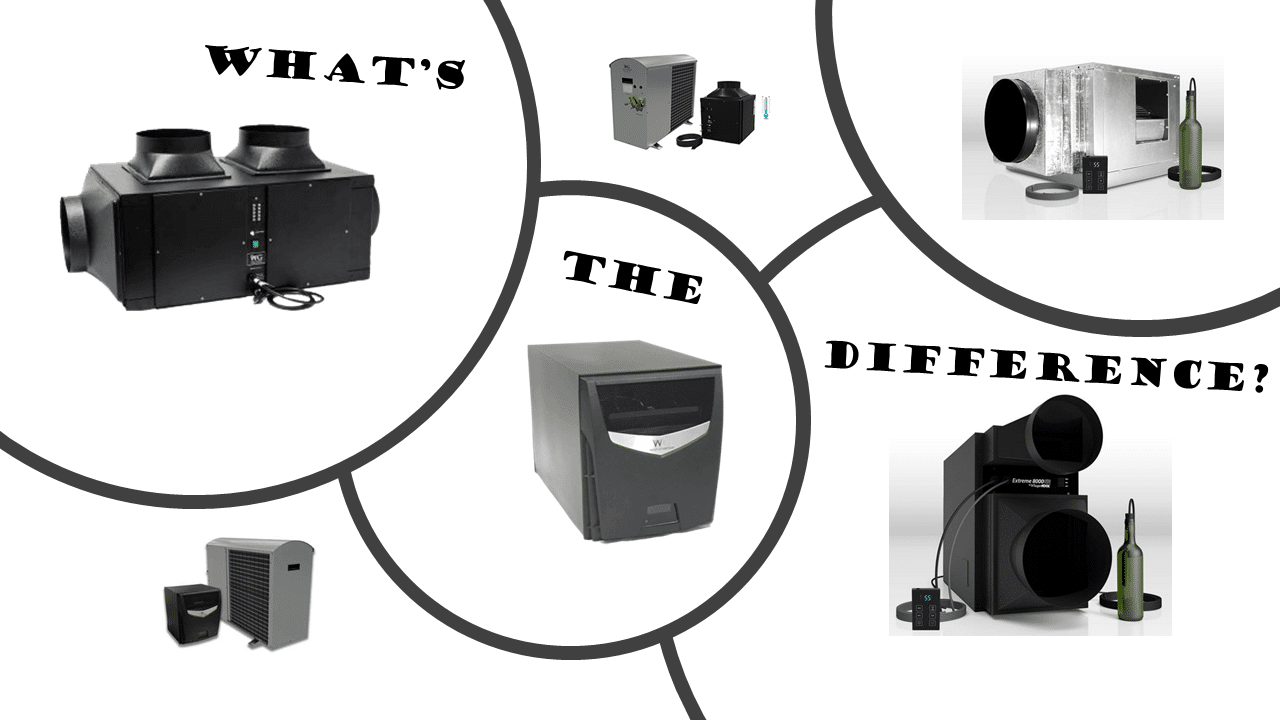
Wine cellar cooling systems come in lots of different types. What’s the difference between them all?
Choosing the right type of wine cellar cooling unit is a critical step in any commercial or residential wine cellar construction project. It is vital to get this right before any design work is started.
You should consider the insulation, vapor barrier, wall, and ceiling construction, and the general way the room is sealed as part of the cooling system setup.
The terms “cooling system” and “refrigeration system” are used interchangeably by most manufacturers. In either case, the system must be able to maintain a constant temperature with minimal variance over time.
This is very unlike an HVAC air conditioning system. The equipment is different, and the cooling system installation and construction methods are different.
How to Decide on the Best Wine Cellar Cooling Units & Systems
For the cooling system itself, there are three main types of wine cellar refrigeration systems from which to choose. In this article, we will be purely discussing the cooling system types. Go here for details on insulation and room construction.
Each type of cooling system has its own unique benefits, pros, and cons. To help you understand the fundamental nature, benefits, and differences between these systems, we have described and illustrated them below.
Remember, the objective is to maintain a consistent, stable, and ideal environment in custom wine rooms and custom wine cabinets. Factors to balance in doing this are the location, the constraints, and the size of your wine cellar, along with the initial cost, the running costs, and the ease of system maintenance for temperature and humidity control.
In each of the following types of systems, the size or capacity of the unit is also an important factor. Always have a specialist in wine room cooling system size the needed system. Do not guess.
The Four Primary Wine Cellar Cooling System Types
-
- Self-contained through-the-wall Cooling Units
- Ductless-Split Wine Cellar Refrigeration Systems
- Ducted Split air handler Wine Cellar Climate Control Systems
- Ducted Self-contained Air Handler Wine Cellar Climate Control Systems
Self-Contained Through-the-wall Wine Cellar Cooling Units
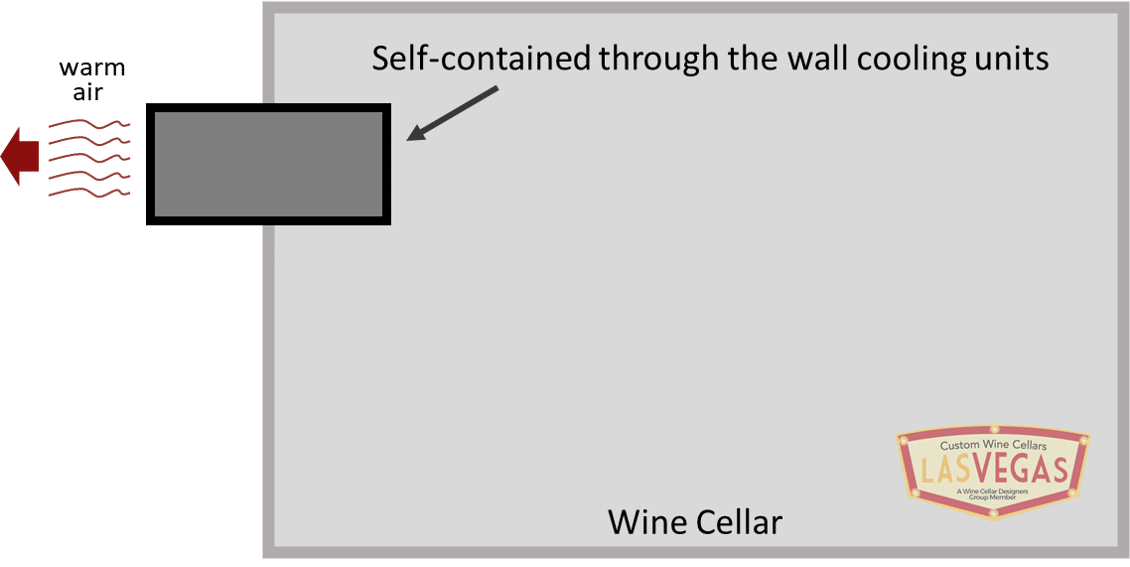
Self-contained Through-the-wall Wine Cellar Cooling Units – Simplest and generally the least expensive to install. Come in one piece, mount on the wall and vent through-the-wall.
These units are the simplest and generally the least expensive to install. They come in one piece, mounted on the wall, and vent through the wall.
When considering self-contained cooling units, decide the best wall for placement and exhaust.
Many self-contained systems need to be mounted on an interior wall and exhaust the hot air and fan noise they create into an adjacent room. This room will need to be very well-ventilated in order to accommodate the heat vented from the unit.
It is a common mistake with this type of wine cellar cooling unit to vent into a room that is too small or poorly ventilated.
A good rule of thumb is that the adjoining room should be at least the same size as your wine cellar and not typically exceed 80°F.
Rooms that are ideal for this heat and noise can be furnace rooms, mechanical rooms, unfinished portions of a basement, and possibly even a garage.
External Venting for Wine Rooms – Las Vegas Environment
Some self-contained cooling units can be installed on an exterior wall. In this scenario, it is vital to be sure that the manufacturer offers a model that will operate effectively and efficiently in temperatures up to the highest possible temperature in your location. Needless to say, Las Vegas will test even the best equipment occasionally hitting temperatures in excess of 111°F.
With only a few exceptions, self-contained systems are sealed by the manufacturer and will have to be removed from the wine cellar wall and shipped to the manufacturer for service or repair. This can be a pain and inconvenient at best.
Ductless Split Cooling Systems
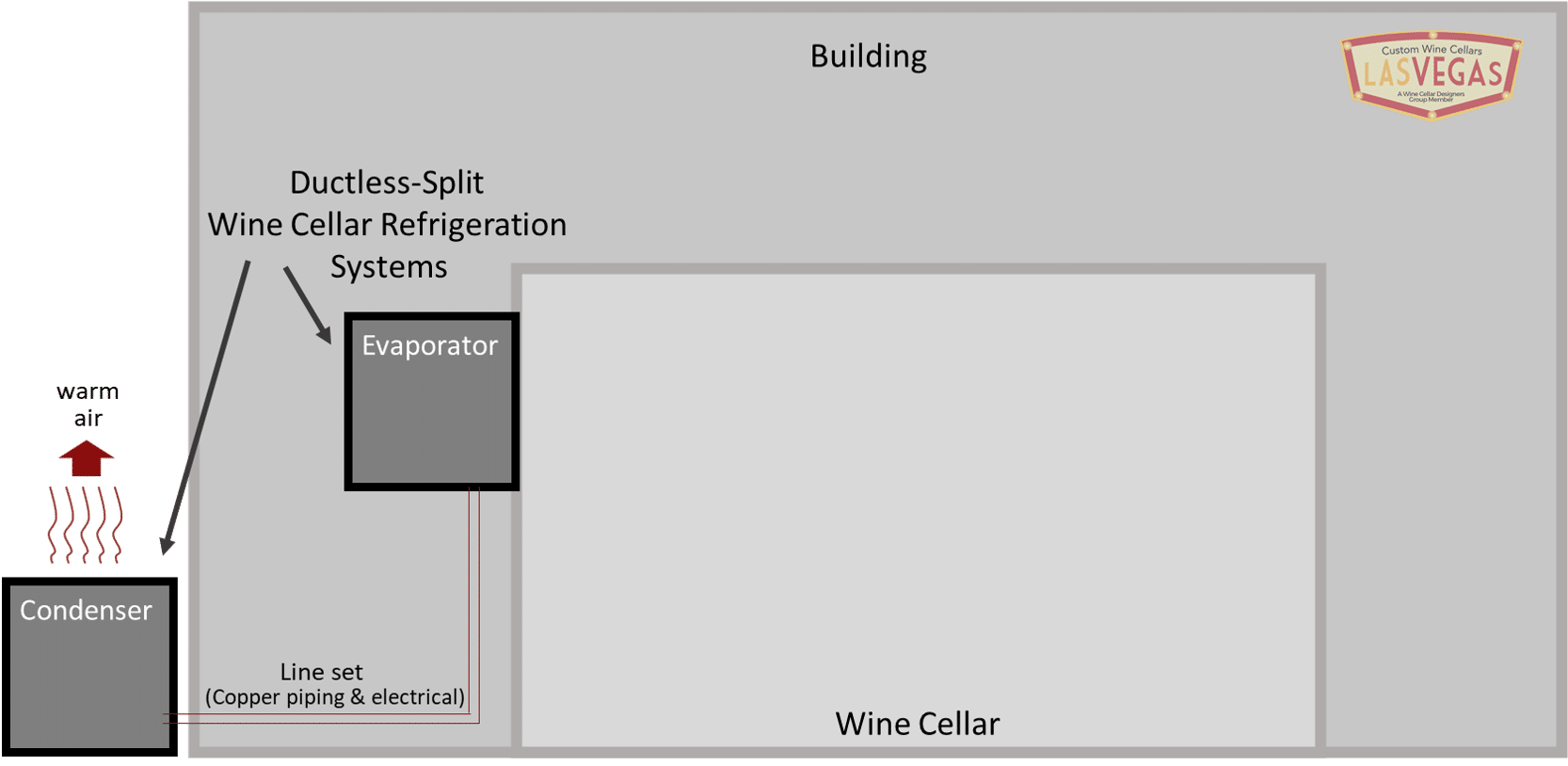
Ductless-Split Wine Cellar Refrigeration Systems – More expensive but require no venting into an adjoining room, the condenser can be located outside the building.
An alternative, albeit more expensive, option to consider is ductless Split Wine Cellar Cooling Systems.
These require no venting into an adjoining room as the condenser of the unit, the part of the system that produces heat can be located somewhere completely different.
The units are connected by a simple line set. A line set is a small copper tubing pair and electrical wiring. Therefore there is no bulky ducting to route and install.
These units can usually be serviced in situ and on-site making maintenance much more efficient and convenient.
These systems can be more expensive than through-the-wall systems as there is more to them.
However, there are many advantages to them that offset this cost. These include longer life expectancy, elimination of fan noise and heat exhaust to other rooms, straightforward installation, and the ability of the system to be serviced on-site.
Ducted-split and Self-contained Air Handler Wine Cooling Units
A completely different type of cooling system is a Wine Cellar Cooling Air Handler. With this type of system, there is no visible equipment in the wine cellar at all. Just a register and a return just like with the HVAC system in your home. The register pushes cold air into the room, and the return takes warmer air to the cooling system.
The cooled air is simply ducted to and from the wine cellar. Therefore, in this type of wine cooling unit, there is ducting but no evaporator in the wine cellar at all.
There are two types of Air Handlers
- Ducted Split Air Handlers
- Ducted Self-contained Air Handlers
Ducted Split Air Handlers
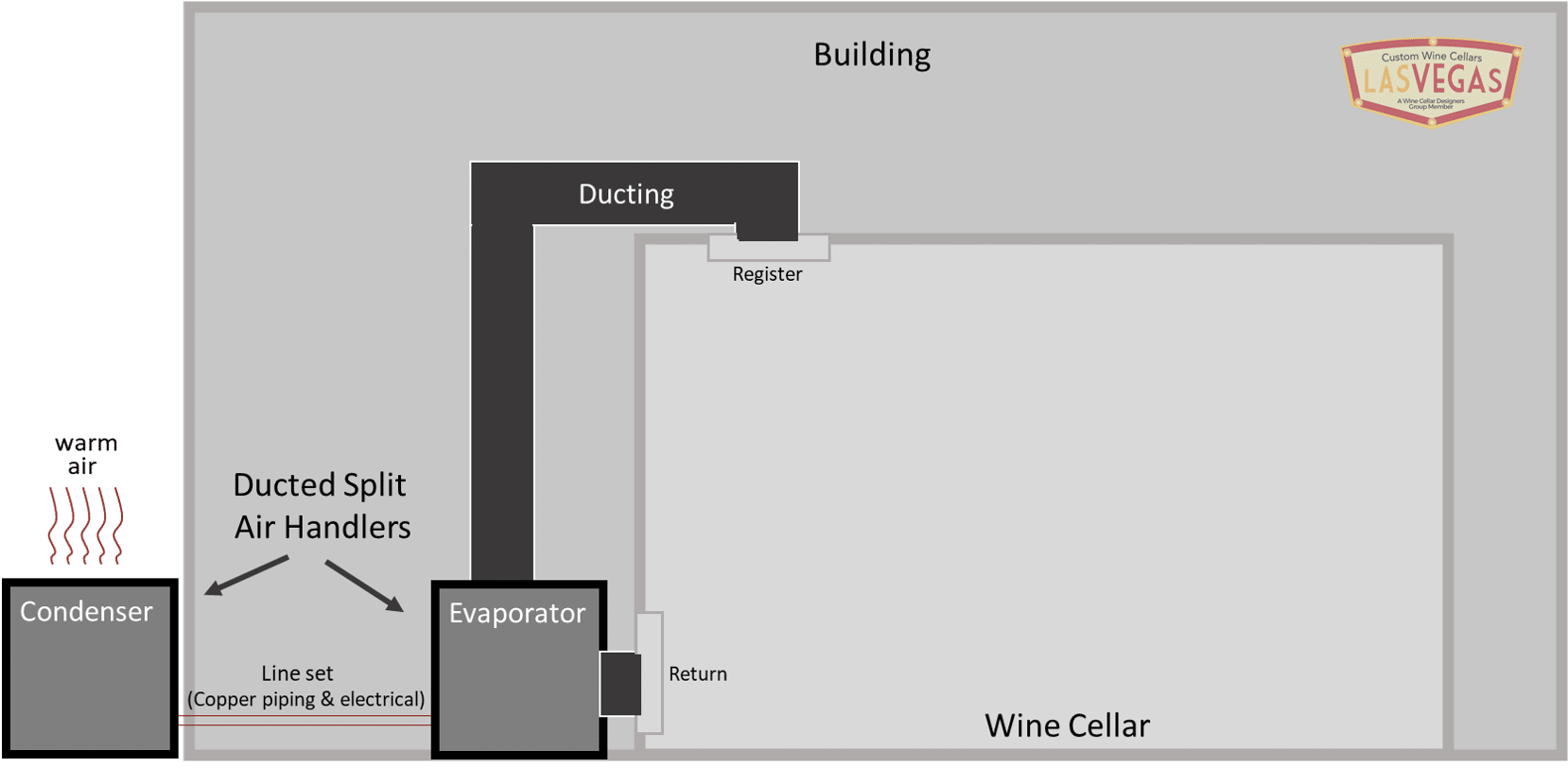
Evaporator and condenser are separate units intended to be located in different places. Evaporator inside and condenser outside. Quiet, but ducting has to be installed.
With Ducted Wine Cellar Cooling Split Air Handlers, the evaporator and the condenser are completely separate units.
The two units are intended to be located in different places, the evaporator inside and the condenser outside the building.
These are the quietest of the different types of refrigeration systems. The downside is that ducting has to be installed to and from the wine cellar. Depending upon the location of the wine cellar this may be easy or potentially very difficult.
As with Ductless Split Systems, these are usually very easy to maintain.
They have a longer life expectancy, eliminate fan noise, and have no heat exhaust to other rooms. In addition, it has straightforward installation and the ability of the system to be serviced on site.
Ducted Self-contained Air Handlers
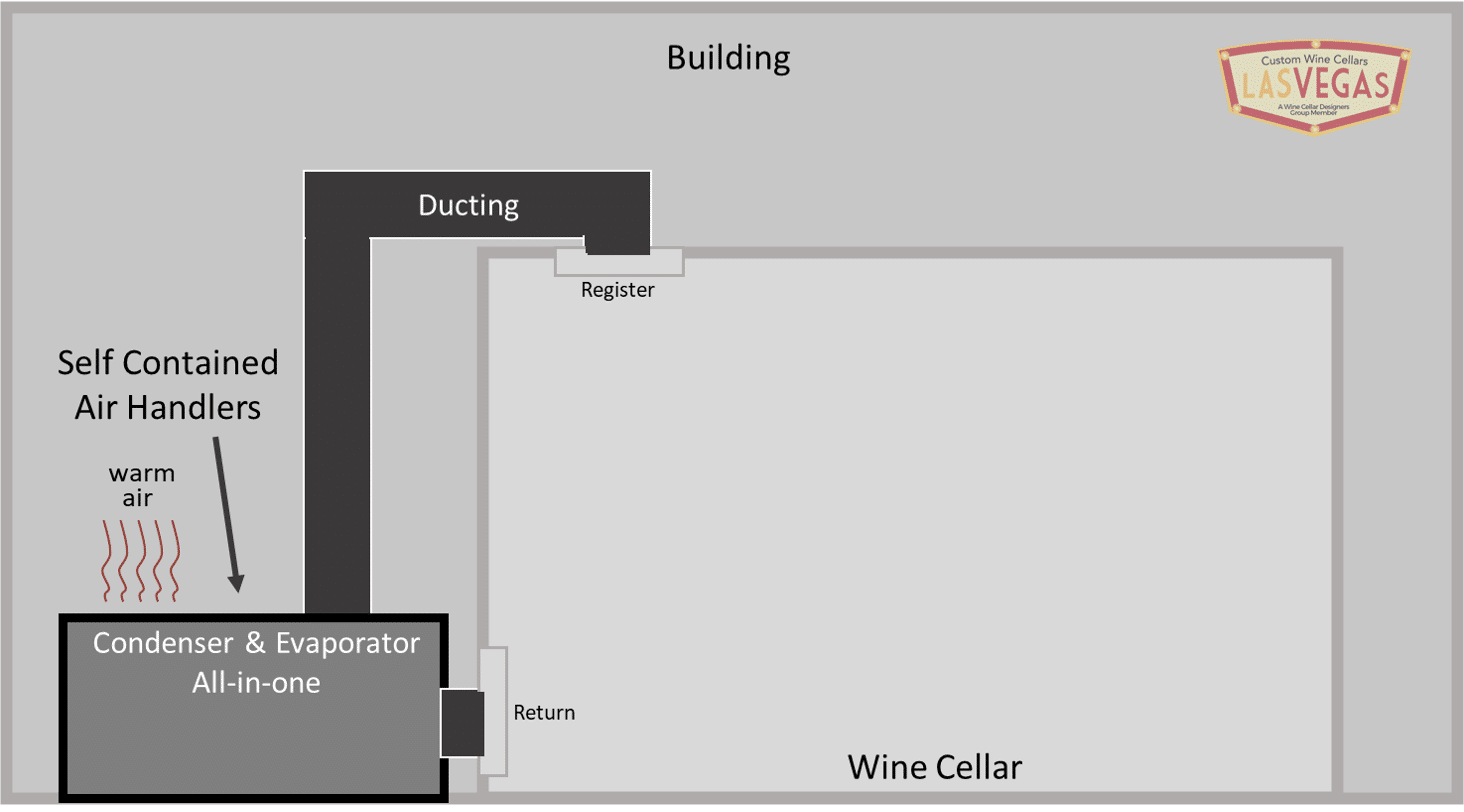
Self-Contained air handlers have both the evaporator and the condenser housed in a single unit. Install when there is no access to the outside of the building. Be sure that it vents into a larger well-ventilated room.
Self-Contained air handlers (not to be confused with Self-Contained Wine Room Cooling Units depicted in the first image) have both the evaporator and the condenser housed in a single unit.
The benefit of these systems is that they can be installed when there is no access to the outside of the building.
The downside is that they need to be installed in a larger well-ventilated room as all the warm air from the cellar will be vented into it.
Check out our high-quality cooling units from CellarPro!
US Cellar Systems is also one of our partners for your wine cooling needs!
How does Custom Wine Cellars Las Vegas help you negotiate these options?
On request one of our experienced wine cellar designers will consult with you to understand your specific preferences and physical constraints. They will take those into account, first performing a heat load calculation to determine the proper BTUs (sizing) needed for the wine cellar’s location.
 Factors such as room size, R-factors, presence of glass, ambient conditions, and location of the wine cellar are all taken into account to provide you with a much more specific set of options for the type of systems and the specific models that will best suit your conditions.
Factors such as room size, R-factors, presence of glass, ambient conditions, and location of the wine cellar are all taken into account to provide you with a much more specific set of options for the type of systems and the specific models that will best suit your conditions.
Want to learn more about Wine Cellar Designs and Wine Cellar Cooling Systems?
At Custom Wine Cellars Las Vegas, we have a gallery of beautiful wine cellars and an extensive selection of full wine cellar builders project stories for you to view. The individual projects include details of specific wine cellar cooling systems and why and how they were installed.
Wine Cellar Cooling Questions?
One of our experienced wine cellar design consultants will create the custom wine cellar design of your dreams for you at no obligation to you. At Custom Wine Cellars Las Vegas, we will go out of our way to make the whole process as easy and as hassle-free for you as possible.
Do you have any questions about the types and installation of wine cellar refrigeration systems? Call us at +1 (702) 866-9544 today! Or complete a simple Wine Cellar Design Request.



